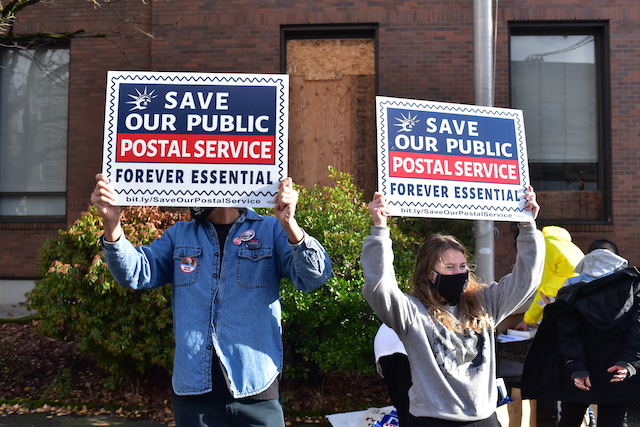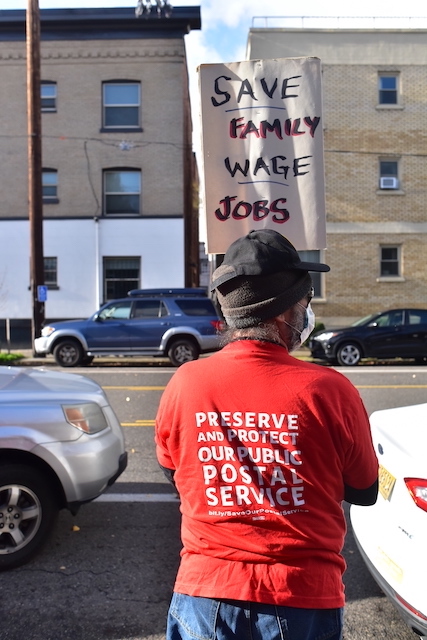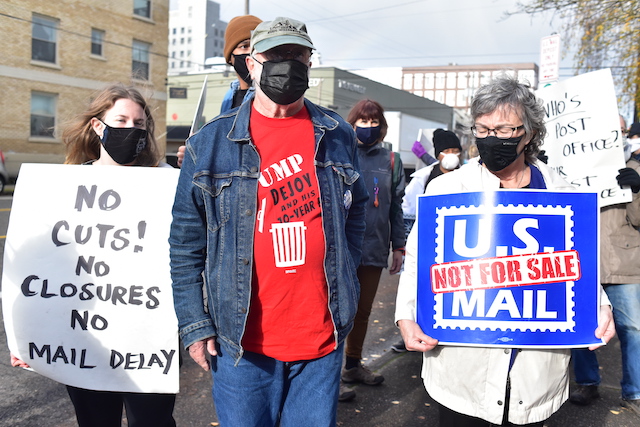
Story and photos by Pete Shaw
As with so many figures who rose to prominence and power during the Republican Trump Administration, US postmaster general Louis DeJoy has never been shy or subtle about his intentions. Appointed by the Board of Governors of the United States Postal Service (USPS) in May 2020, DeJoy wasted no time upon assuming office a month later in seeking to dismantle an already hobbled USPS. He immediately began cutting mail service, removing mail sorting machines, and implementing other policies such as banning overtime and extra trips to deliver mail, all the while dismantling sorting machines and removing neighborhood postal boxes. These were all done during the run up to the 2020 election which was going to see, due to the Covid-19 pandemic, millions of votes cast by mail. While some of these “reforms” were abandoned, the slowdown in mail service continued through the December holidays as DeJoy failed to make sure post offices had adequate staffing to deal with the holiday rush as well as the impact of Covid-19 on the postal workforce.
Earlier this year, DeJoy announced his ten year “Delivering for America” plan that if followed through would be disastrous for both the Postal Service and the country as a whole. So far, his scheme, which rolled out in October, has predictably resulted in slower mail delivery, increased prices, cuts in post office hours, closed mail facilities, and outsourced postal work.
On Wednesday December 9, a crowd of nearly 50 people gathered at noon outside the US post office on SE 7th Avenue demanding that President Joseph Biden and the Democratic Party work toward getting rid of DeJoy and take the needed steps to reinvigorate the USPS.
“What we need right now,” said Dave Norton, president of the National Association of Letter Carriers, Branch 82, “is a postmaster general to implement plans to strengthen the Postal Service, to make it stronger, to make it more efficient, to make it last forever for the American public. And that’s gonna start with dumping DeJoy.”
While DeJoy’s blueprint for the Postal Service is horrid, it is not entirely aberrant. Since 1971, when the Postal Service transitioned from an official part of the US government to an independent government agency, it has been in the crosshairs of those seeking to privatize its services. In particular, over the past 15 years, the USPS has been attacked by politicians chipping away at it. Whether it was President George W. Bush signing the Postal Accountability and Enhancement Act (PAEA) which forced the USPS to pre-fund over the course of ten years future health care benefit payments to retirees for the next 75 years, or Postmaster General Megan Brenna seeking to reduce over 12,000 postal positions nationwide in 2017, or the 2020 experiment with consolidated casing that due to public outcry was abandoned, the goal has been to turn the Postal Service into something it is not.

“Our postal system,” Oregon State Representative Rob Nosse told the crowd, “is a national treasure. It’s a service, not a business. It delivers medicine, correspondence, bills, payments, checks, legal documents, parcels, advertising and, of course at this time of year, it’s holiday cards and packages and presents.”
As a service, the purpose of the Postal Service is not to turn a profit. Rather, it is to provide for the people of the United States. According to Title 39 of the US code, the Postal Service “shall provide prompt, reliable, and efficient services to patrons in all areas and shall render Postal Services to all communities. The costs of establishing and maintaining the Postal Service shall not be apportioned to impair the overall value of such service to the people.”
Title 39 goes on to state, “The Postal Service shall provide a maximum degree of effective and regular Postal Services to rural areas, communities, and small towns where post offices are not self-sustaining. No small post office shall be closed solely for operating at a deficit, it being the specific intent of the Congress that effective Postal Services insured to residents of both urban and rural communities.”
It is the United States Postal Service, not the Post Office corporation. And because it has been run as a service, providing the same costs no matter whether you live in a city or in a sparsely populated rural area, the USPS is immensely popular among people of all political stripes. A Pew Research Center survey taken in March 2020 found that 91% of respondents have a favorable view of the US Postal Service, a level of support beyond that for any other federal agency.
The USPS is not a publicly funded institution. Save for a one-time Covid-19 related grant, it pays for its operations through the sale of the services it offers its customers, such as stamps and other postage. While it has been experiencing some financial woes–the financial crisis of 2008 hit it hard, and the rise of email and other computer based messaging services have taken a toll–much of that debt has to be laid at the feet of Congress. The 2006 PAEA required the USPS, unlike every other private corporation or governmental agency in the country, to pre-fund the healthcare of retirees for the next 75 years. Yearly, it has been setting aside between $5.4 and $5.6 billion per year to pay for benefits that would be received by some postal workers who had yet to be born.
If the purpose of DeJoy’s plan is indeed to make the USPS a better servant of the people of the United States, then it makes no sense. But if his scheme’s purpose is to destroy this venerable institution, then DeJoy and his machinations are right on point.
“We are just over two months into Postmaster DeJoy’s disastrous ten year plan,” said Daniel Cortez, legislative and political director of the American Postal Workers Union. “It was designed for no other reason than to hasten the demise of the Postal Service. The entire ten year plan–the idea that somehow the Postal Service is going to erode and dismantle service in order to treat our customers better is ludicrous.”
As an example, Cortez talked about how DeJoy’s plan seeks to decrease turnover among the “non-career” employees.
“As anybody knows,” asserted Cortez, “the best way to decrease turnover among your employees is to treat them better. For years, the Postal Service around the country, particularly here in Portland, has fought to prevent the transition from non-career to career. They are now reaping what they sow. We have window lines out the building. Mail is being slowed down. We have letter carriers out all hours of the night, simply because the postal management cannot or will not fill the positions that we need to provide the service that is the backbone of the United States Postal Service.”
The path forward is not as cut and dry as Biden simply firing DeJoy. The postmaster general is not appointed by the president, but rather, by the USPS Board of Governors. Those governors–there are up to nine of them, and no more than five may belong to the same political party–are appointed by the president.

But just prior to last Wednesday’s rally, Biden announced that he would be seeking replacements on the USPS Board of Governors for John Barger and Chair Ron Bloom, both of whom are considered close allies of DeJoy. Biden has nominated Daniel M. Tangherlini and Derek Kan, a Democrat and a Republican, respectively, to replace them. In February, Biden nominated two Democrats and an independent to the Board of Governors, all of whom were confirmed by the Senate. Should Tangherlini and Kan be confirmed, the makeup of the Board of Governors will be four Democrats, four Republicans, and one independent.
It is not clear that the potential new makeup of the board will provide the five votes necessary to oust DeJoy. But it seems obvious that if the Postal Service is to remain a vital institution, DeJoy must go and his Delivering for America plan jettisoned.
This is a matter of concern for all people in the US. As Barbara Smith Warner, an Oregon State Representative who for three years was the legislative and political trainer for the National Association of Letter Carriers in nine western states said, “This is not just an urban issue, this is a national issue. If they got their way and privatized the Postal Service, sure, everybody would snatch up maybe the Portland to Eugene routes, the LA to Vegas. But who’s gonna continue delivering to Baker City? Or to Bend? Or to John Day?”
But beyond this, it is high time the purpose of the USPS was reconsidered. In some cases, re-reconsidered. From 1911 to 1967, the United States Post Office Department (the predecessor to the USPS) offered deposit accounts. In 1947, when those deposits peaked, the postal savings system held nearly $3.4 billion. While it did not offer all the services of traditional banks, there is no reason that today’s USPS could not do so.
Emily Golden-Fields of the Portland branch of the Democratic Socialists of America offered up other possible uses for post offices. She offered that they could be centers for public broadband internet access, one stop government resources where people can get welfare and social security checks, and they could also be food banks. The possibilities may not be endless, but they are vast.
“Our post office can be so much,” Golden-Fields said. “We not only want to defend it. We want to build it.”






